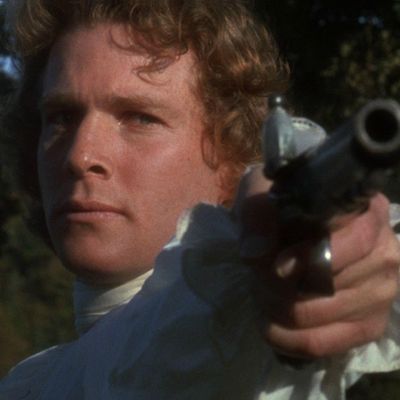
He never really stopped looking like a child, did he? All the way until the end. Ryan OÔÇÖNealÔÇÖs gift and his curse was that face ÔÇö those pleading eyebrows, that placid mouth, those round cheeks. It was what allowed him to play, at the age of 34, Irish teenager Redmond Barry in Stanley KubrickÔÇÖs masterpiece Barry Lyndon. Some wondered why Kubrick, the great perfectionist, had cast a star already known for being messy and difficult. (IÔÇÖm fairly certain Kubrick himself wondered this halfway through production.) There were some obvious reasons, box-office appeal among them, but it was also probably partly because OÔÇÖNeal was the rare actor who could convincingly play Barry in his youth and as a middle-age man over the course of the film. (Another reason, of course, was that KubrickÔÇÖs daughters adored him.)
This wasnÔÇÖt just a fortuitous conjunction of facial features. It was also an onscreen attitude ÔÇö a certain puppy-dog lostness that was ever-present in OÔÇÖNealÔÇÖs performances. A less charitable reading might suggest that this was because he was himself lost, and perhaps the personal wreckage he always seemed to leave behind him would confirm that. Enough ink has been spilled over the years about OÔÇÖNealÔÇÖs behavior and his many addictions. Tatum OÔÇÖNealÔÇÖs riveting 2001 memoir, A Paper Life, a sizable chunk of which is about the time she spent in Ireland and England while her father shot Barry Lyndon, is a catalogue of horrors. But it was also nice to see father and daughter reconcile in later years. A photo Tatum shared from earlier this year shows Ryan with a big beaming smile; even at 82, he still looked so much like a little kid.
Many have noted that for an actor who was often regarded as a punch line by critics, Ryan OÔÇÖNeal had an uncanny ability to show up in some extraordinary films. Not just Barry Lyndon, but also Peter BogdanovichÔÇÖs WhatÔÇÖs Up, Doc? and Paper Moon (and later, the directorÔÇÖs terrific but less well regarded Nickelodeon), as well as Walter HillÔÇÖs The Driver. These arenÔÇÖt just great films; they are great films, all-timers, the kind of movie any self-respecting actor would feel lucky to have even one of in their r├®sum├®.
These movies are all quite different, but what unites them perhaps is that each calls for an emotionally stunted protagonist out of step with the world around him. In Paper Moon, TatumÔÇÖs 9-year-old Addie Loggins shows herself to be more mature in a lot of ways than RyanÔÇÖs ostensible adult con artist Mo Pray. In WhatÔÇÖs Up, Doc?, OÔÇÖNeal is the straightest of straight men, a hapless, igneous-rock-obsessed musicologist from Iowa who exists primarily to be tossed this way and that by the human tornado that is Barbra StreisandÔÇÖs Judy Maxwell. In The Driver, playing a nameless getaway driver who is extremely good at his job but also barely utters a word and clearly regards everyone around him with simmering contempt, he is a man of such pure action he somehow achieves passivity; he moves relentlessly through space and time with almost no agency. And then of course thereÔÇÖs Barry Lyndon, a film about a poor, lovelorn Irish lad who flees home, discovers the world, becomes a continental striver, marries into the English nobility, and is then destroyed when he tries to become just like the people around him.
Any rudimentary screenwriting class will teach you that passive protagonists are a no-no. Lead characters have goals. They act. They move. They show passion and they struggle. They enter into conflict. They face obstacles. They prevail. This is what gives us drama. But over and over in these films, Ryan OÔÇÖNeal plays that most unlikely thing in movies: a character to whom things happen, to whom things are done to. When he tries to seize control, heÔÇÖs beaten down all over again. This is even true to a certain extent of Love Story, the massive hit that turned OÔÇÖNeal and Ali MacGraw into huge stars. Regardless of whether you love or hate that film (I think itÔÇÖs pretty good), itÔÇÖs hard not to walk away from it even today in awe of the supernova chemistry of its two stars ÔÇö the sassy, playful Radcliffe girl and the emotionally constipated Harvard jock struggling to escape the shadow of his stern father who winds up losing the love of his life.
Indeed, some of the greatest films ever made have been about passive characters, and a fair number of them were made in the 1970s in the United States, and a surprising number of those starred Ryan OÔÇÖNeal. A generation was tumbling out of the ÔÇÖ60s and swirling through the chaos of the ÔÇÖ70s. So, the heroes of these films ÔÇö even if the films were set in 18th-century Britain ÔÇö didnÔÇÖt transform their world, but were rather at its cruel mercy. (Maybe thatÔÇÖs why these movies still resonate. We are all passive protagonists in the universe ÔÇö more Redmond Barrys than Michael Corleones.)┬áWhatever we may have thought about the arc of his career or his life, we canÔÇÖt take these performances away from OÔÇÖNeal. Nor would we want to. Great actors use their skill; great stars use their limitations. Ryan OÔÇÖNeal had talent, but he also clearly understood his limitations, which is probably why for a moment he became one of the biggest stars in HollywoodÔÇÖs firmament ÔÇö American cinemaÔÇÖs looking-glass prince.
More From Movies
- Flow Is an Animal Adventure ThatÔÇÖs Endearing and a Little Too Pretty
- The 30 Best Movies on AmazonÔÇÖs Prime Video Right Now
- The 20 Best Movies for Kids on Netflix


